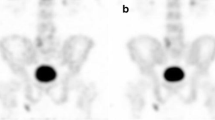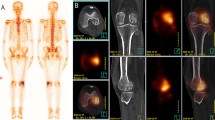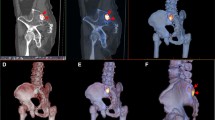Abstract
Purpose
To evaluate single photon emission computed tomography (SPECT)/spiral computed tomography (CT) fusion imaging for the diagnosis of bone metastasis in patients with known cancer and to compare the diagnostic efficacy of SPECT/CT fusion imaging with that of SPECT alone and with SPECT + CT.
Materials and methods
One hundred forty-one bone lesions of 125 cancer patients (with nonspecific bone findings on bone scintigraphy) were investigated in the study. SPECT, CT, and SPECT/CT fusion images were acquired simultaneously. All images were interpreted independently by two experienced nuclear medicine physicians. In cases of discrepancy, consensus was obtained by a joint reading. The final diagnosis was based on biopsy proof and radiologic follow-up over at least 1 year.
Results
The final diagnosis revealed 63 malignant bone lesions and 78 benign lesions. The diagnostic sensitivity of SPECT, SPECT + CT, and SPECT/CT fusion imaging for malignant lesions was 82.5%, 93.7%, and 98.4%, respectively. Specificity was 66.7%, 80.8%, and 93.6%, respectively. Accuracy was 73.8%, 86.5%, and 95.7%, respectively. The specificity and accuracy of SPECT/CT fusion imaging for the diagnosis malignant bone lesions were significantly higher than those of SPECT alone and of SPECT + CT (P < 0.05). Among 37 equivocal lesions revealed with SPECT, the diagnostic accuracy of bone lesions was 45.9% for SPECT + CT and 81.1% for SPECT/CT fusion imaging (χ2 = 9.855, P = 0.002). The numbers of equivocal lesions were 37, 18, and 5 for SPECT, SPECT + CT, and SPECT/CT fusion imaging, respectively, and 29.7% (11/37), 27.8% (5/18), and 20.0% (1/5) of lesions were confirmed to be malignant by radiologic follow-up over at least 1 year.
Conclusions
SPECT/spiral CT is particularly valuable for the diagnosis of bone metastasis in patients with known cancer by providing precise anatomic localization and detailed morphologic characteristics.


Similar content being viewed by others
References
Chowdhury FU, Scarsbrook AF. The role of hybrid SPECT-CT in oncology: current and emerging clinical applications. Clin Radiol. 2008;6:241–51.
Rybak LD, Rosenthal DI. Radiological imaging for the diagnosis of bone metastases. Q J Nucl Med. 2001;45:53–64.
Even-Sapir E. Imaging of malignant bone involvement by morphologic, scintigraphic and hybrid modalities. J Nucl Med. 2005;46:1356–67.
Love C, Din AS, Tomas MB, Kalapparambath TP, Palestro CJ. Radionuclide bone imaging: an illustrative review. Radiographics. 2003;23:341–58.
Bushnell DL, Kahn D, Huston B, Bevering CG. Utility of SPECT imaging for determination of vertebral metastases in patients with known primary tumors. Skeletal Radiol. 1995;24:13–6.
Reinartz P, Schaffeldt J, Sabri O, et al. Benign versus malignant osseous lesions in the lumbar vertebrae: differentiation by means of bone SPET. Eur J Nucl Med. 2000;27:721–6.
Townsend DW. Dual-modality imaging: combining anatomy and function. J Nucl Med. 2008;49:938–55.
Schillaci O, Danieli R, Manni C, Simonetti G. Is SPECT/CT with a hybrid camera useful to improve scintigraphic imaging interpretation? Nucl Med Commun. 2004;5:705–10.
Horger M, Eschmann SM, Pfannenberg C, et al. Evaluation of combined transmission and emission tomography for classification of skeletal lesions. AJR Am J Roentgenol. 2004;183:655–61.
Horger M, Bares R. The role of single-photon emission computed tomography/computed tomography in benign and malignant bone disease. Semin Nucl Med. 2006;36:275–85.
Delbeke D, Edward RC, Guiberteau MJ, et al. Procedure guideline for SPECT/CT imaging 1.0. J Nucl Med. 2006;47:1227–34.
Daisuke U, Shinya S, Masanori I, et al. Added value of SPECT/CT fusion in assessing suspected bone metastasis: comparison with scintigraphy alone and nonfused scintigraphy and CT. Radiology. 2006;238:264–71.
Roarke MC, Nguyen BD, Pockaj BA. Applications of SPECT/CT in nuclear radiology. AJR Am J Roentgenol. 2008;191:W135–50.
Strobel K, Burger C, Seifert B, et al. Characterization of focal bone lesions in the axial skeleton: performance of planar bone scintigraphy compared with SPECT and SPECT fused with CT. AJR Am J Roentgenol. 2007;188:W467–74.
Roach PJ, Schembri GP, Ho Shon IA, et al. SPECT/CT imaging using a spiral CT scanner for anatomical localization: impact on diagnostic accuracy and reporter confidence in clinical practice. Nucl Med Commun. 2006;27:977–87.
Romer W, Nomayr A, Uder M, et al. SPECT-guided CT for evaluating foci of increased bone metabolism classified as indeterminate on SPECT in cancer patients. J Nucl Med. 2006;47:1102–6.
Keidar Z, Israel O, Krausz Y. SPECT/CT in tumor imaging: technical aspects and clinical applications. Semin Nucl Med. 2003;33:205–18.
Ruf J, Lehmkuhl L, Bertram H, et al. Impact of SPECT and integrated low-dose CT after radioiodine therapy on the management of patients with thyroid carcinoma. Nucl Med Commun. 2004;25:1177–82.
Schillaci O. Hybrid SPECT/CT: a new era for SPECT imaging. Eur J Nucl Med Mol Imaging. 2005;32:521–4.
Romer W, Beckmann MW, Forst R, Bautz W, Kuwert T. SPECT/spiral-CT hybrid imaging in unclear foci of increased bone metabolism: a case report. Rontgenpraxis. 2005;55:234–7.
Pomeranz SJ, Pretorius HT, Ramsingh PS. Bone scintigraphy and multimodality imaging in bone neoplasia: strategies for imaging in the new health care climate. Semin Nucl Med. 1994;24:188–207.
Ghanem N, Uhl M, Brink I, et al. Diagnostic value of MRI in comparison to scintigraphy, PET, MS-CT and PET/CT for the detection of metastases of bone. Eur J Radiol. 2005;55:41–55.
Schmidt GP, Reiser MF, Baur-Melnyk AB. Whole-body imaging of the musculoskeletal system: the value of MR imaging. Skeletal Radiol. 2007;36:1109–19.
Tian R, Su M, Tian Y, et al. Dual-time point PET/CT with F-18 FDG for the differentiation of malignant and benign bone lesions. Skeletal Radiol. 2009;38:451–8.
Acknowledgements
We thank BioMed Proofreading for assistance in editing the manuscript. We also thank the technicians in nuclear medicine for their enduring support during this study.
Author information
Authors and Affiliations
Corresponding author
Rights and permissions
About this article
Cite this article
Zhao, Z., Li, L., Li, F. et al. Single photon emission computed tomography/spiral computed tomography fusion imaging for the diagnosis of bone metastasis in patients with known cancer. Skeletal Radiol 39, 147–153 (2010). https://doi.org/10.1007/s00256-009-0764-0
Received:
Revised:
Accepted:
Published:
Issue Date:
DOI: https://doi.org/10.1007/s00256-009-0764-0




